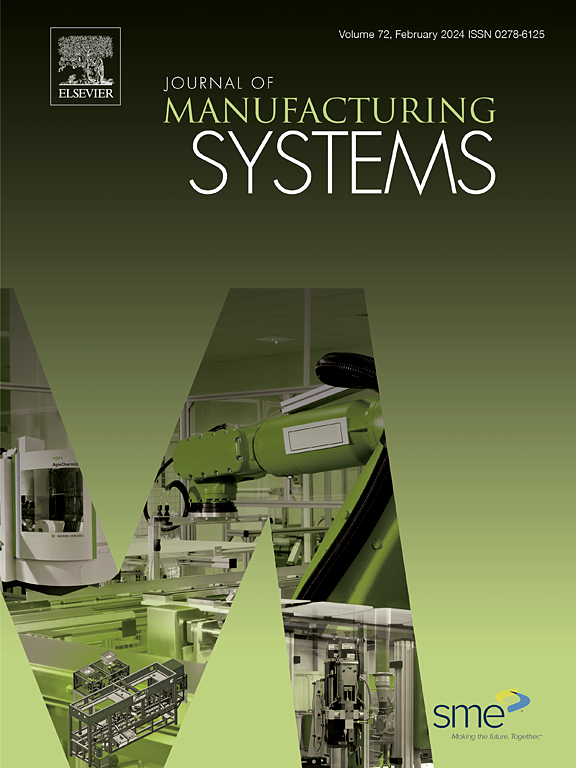基于数字孪生和IGA-TS的人机协同装配动态任务分配框架
IF 12.2
1区 工程技术
Q1 ENGINEERING, INDUSTRIAL
引用次数: 0
摘要
人机协同装配被认为是智能制造系统的重要组成部分,它将人的灵活性与机器的效率相结合,从而提高装配任务的有效性和适应性。然而,对不断变化的情景的适应性、决策和响应性方面的挑战仍然存在。为了解决这些问题,本文提出了一种数字双驱动的任务分配决策方法,使用改进的禁忌搜索遗传算法(IGA-TS)。首先,建立了装配任务评价模型和数字孪生框架,以支持动态决策。随后,IGA-TS算法集成了自定义编码方案、适应度函数、禁忌列表和邻域搜索,避免了局部最优,提高了全局寻优和收敛速度。最后,结合人体建模和运动识别的数字孪生辅助系统,实现实时优化反馈,形成协作闭环。实验结果表明,IGA-TS在多目标优化方面优于传统的遗传算法和启发式方法,减少了装配时间、任务复杂度和人工工作量。此外,所设计的数字孪生系统对装配过程中的动态变化具有较强的适应性和鲁棒性,为制造业车间装配提供了实用可行的解决方案。显著提高了生产效率和产品质量,具有较大的工业应用价值。本文章由计算机程序翻译,如有差异,请以英文原文为准。
A dynamic task allocation framework for human-robot collaborative assembly based on digital twin and IGA-TS
Human-robot collaborative assembly is recognized as an essential component of intelligent manufacturing systems, combining human flexibility with machine efficiency, thereby enhancing the effectiveness and adaptability of assembly tasks. However, challenge in adaptability, decision-making, and responsiveness to changing scenarios persist. To address these, this paper propose a digital twin-driven decision-making approach for task allocation, using an Improved Genetic Algorithm with Tabu Search (IGA-TS). First, an assembly task evaluation model and digital twin framework are developed to support dynamic decision-making. Subsequently, the IGA-TS algorithm integrates a custom encoding scheme, fitness function, tabu list, and neighborhood search to avoid local optima, enhancing global optimization and convergence speed. Lastly, a digital twin-assisted system, combining human body modeling and motion recognition, enables real-time optimization feedback, forming a closed-loop for collaboration. Experimental results show that IGA-TS outperforms traditional genetic algorithms and heuristic methods in multi-objective optimization, reducing assembly time, task complexity, and human workload. In addition, the designed digital twin system demonstrates strong adaptability and robustness in responding to dynamic changes during the assembly process, providing a practical and feasible solution for manufacturing workshop assembly. It significantly enhances production efficiency and product quality, offering substantial industrial application value.
求助全文
通过发布文献求助,成功后即可免费获取论文全文。
去求助
来源期刊

Journal of Manufacturing Systems
工程技术-工程:工业
CiteScore
23.30
自引率
13.20%
发文量
216
审稿时长
25 days
期刊介绍:
The Journal of Manufacturing Systems is dedicated to showcasing cutting-edge fundamental and applied research in manufacturing at the systems level. Encompassing products, equipment, people, information, control, and support functions, manufacturing systems play a pivotal role in the economical and competitive development, production, delivery, and total lifecycle of products, meeting market and societal needs.
With a commitment to publishing archival scholarly literature, the journal strives to advance the state of the art in manufacturing systems and foster innovation in crafting efficient, robust, and sustainable manufacturing systems. The focus extends from equipment-level considerations to the broader scope of the extended enterprise. The Journal welcomes research addressing challenges across various scales, including nano, micro, and macro-scale manufacturing, and spanning diverse sectors such as aerospace, automotive, energy, and medical device manufacturing.
 求助内容:
求助内容: 应助结果提醒方式:
应助结果提醒方式:


